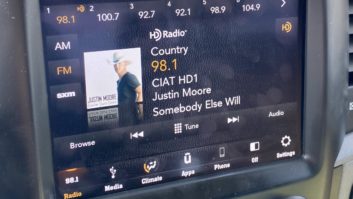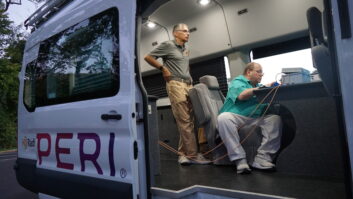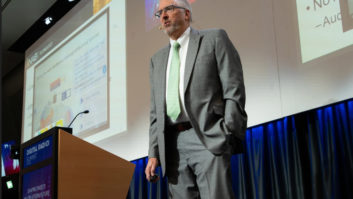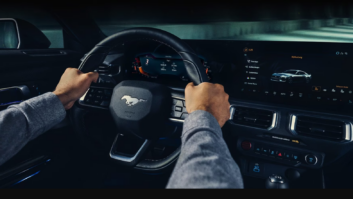It took about 13 years for digital radio in the United States to evolve into something really worth doing. Through a myriad of starts and stops and twists and turns, a privately held company called Ibiquity has sufficiently perfected the technology that will transition American radio broadcasting from its analog heritage to a digital future. Like it or not, HD Radio will likely become radio’s ticket to tomorrow. Radio is the last of the electronic media platforms to embrace the switch from A to D.
Ibiquity had been hoping the HD Radio rollout would be much farther along than it is. At least six months were lost to the codec controversy in which the PAC algorithm was finally tossed out in favor of the MPEG-inspired HDC codec. That glitch appears to be the last big hurdle Ibiquity had to jump over so HD Radio would have clear sailing to the finish line for NRSC endorsement and FCC adoption of an official transmission standard.
A slow start
While the industry has been closely watching this saga play out, most owners of radio stations have been slow to make commitments to license and install the necessary equipment to start broadcasting the hybrid analog-digital mode of HD Radio. Even the early investing partners of USADR like Infinity, Clear Channel and other large group owners have committed only a few of their major market stations to an HD Radio rollout schedule. Greater Media was one of the few major group owners to commit all of their stations to early conversion.
Such reluctance can be mostly explained by the recession, the war on terrorism, the lack of HD Radio technical standards and lingering apprehensions about performance, interference and acceptance by consumers. With an improving economy and anticipated adoption of FCC standards, the HD Radio rollout is starting to get back on track. The major HD Radio transmission gear manufacturers are reporting increases in orders.
Bandwagon gets rolling
Those stations converting early are poised to gain an advantage as the first HD receivers begin hitting the store shelves in time for Christmas in at least the six largest rollout markets. The concerted push to roll out receivers starts in Q1 of 2004. Consumers will soon be able to experience the improved fidelity, cleaner reception and scrolling data text features that HD Radio will provide in the first generation of receivers.
Ibiquity is confident that enough key stations in the large markets will be broadcasting in HD Radio by the end of first quarter 2004, that about 65% of all those listeners will be able to buy a digital radio and enjoy the benefits of HD Radio on at least several of their favorite stations. That’s enough critical mass to establish HD Radio as the preferred platform and hopefully entice consumers who want to buy a new radio to choose an HD model. By 2005, Ibiquity projects about 80% of the U.S. population will be covered by HD broadcasts.
Receivers on the way
To further reinforce the likelihood of permanent long-term success of HD Radio, consider the support and commitment by the receiver manufacturing industry. The ability of companies like Texas Instruments and Philips to integrate all of the decoding functions needed for high-performance HD reception on a single low-cost IC chip will enable the mass production of affordable receivers. It might take a few years before we see a $25 HD Radio portable, but first-generation HD Radio car radios should be priced within $100 of their full-featured analog-only cousins.
Since most receiver companies will want to standardize production around a common chip-set, analog-only radios could be hard to find on store shelves sooner than you think. These companies see digital radio in all forms as a long overdue renaissance of renewed interest in radio and a whole new product line of opportunity. They want to build and sell new-generation digital radios quickly.
Killer-app in the making
Various HD Radio detractors are still complaining about the lack of a killer-app and that without one, consumer acceptance may not materialize. HD Radio is really a collection of small impressive enhancements that when taken on the whole constitute a composite killer-app that will make radio listening a lot more dependable, enjoyable and feature-rich.
If you really insist on having that single killer-app, it’s becoming more likely that the addition of a second program service now being tested in the Tomorrow Radio Initiative could emerge as just that. HDC performance at the lower bit rates has allowed more allocated bits to properly support the second service. Blend to analog would be given up in that scheme, but ongoing field tests by various HD Radio stations are suggesting that blend on FM may not be as important as originally thought.
Not only is NPR excited about the second service, but at least a few commercial owners who are paying attention understand clearly that another program channel which comes virtually for free would make a great vehicle to spread out inventory and create new revenue producing opportunities with fewer commercial interruptions.
There is still some doubt about how AM HD Radio will be able to roll out successfully if interference complaints from adjacent-channel stations become prevalent and nighttime HD Radio operations for many stations are throttled back. According to the NAB, the AM service claims about 19% of all radio listening. The vast majority of that is news, talk and sports during drive time.
Losing the Noise
Digital reception of AM via HD Radio will be more immune to noise, the most destructive form of interference to AM listening. That fact has received little press or attention. Noise sources of all kinds have increased dramatically in recent years and have made AM listening almost impossible in many venues.
The benefit of that feature alone should prove more valuable to most of the stations that adopt HD Radio than stereo or extended frequency response – especially since the latter does not significantly improve talk-based programming. Music formats will gain dramatically from both, of course.
The industry and ultimately the listening public will have to decide which is more important for the greater good of the AM service: Protecting the fringe area or nighttime skywave reception of a few stations for a few of their listeners in areas where interference becomes an issue? Or, protecting the enhanced ability of most people to be able to hear their favorite AM stations clearly via HD Radio in areas they could not do so in analog? And, being able to hear their favorite music station on AM in full fidelity just as if it were FM stereo? Not much of a contest there.
Satellite Competition
The arrival of a viable HD Radio standard comes just in time for terrestrial broadcasters to gain a measure of “digital parity” against the growth of satellite-delivered digital radio. XM Satellite Radio has just celebrated signing up 1 million subscribers. Sirius has 100,000+. By comparison, there are about 200 million people who use free radio on AM and FM. Only about 10% of respondents in a recent CEA radio-use survey say they would consider paying for a satellite subscription. The growth of this service is essentially capped and will begin to level off.
It’s not likely terrestrial broadcasters will pay much effort or attention to counter marketing the advantages of their new digital service against the satellite boys. Most would argue that the appeal of satellite is mostly about offering a deep variety of niche format programming and serving those long-haul truckers caught in the middle of nowhere with little to choose from, rather than much to do with technical quality or interference-free performance.
As long as terrestrial continues to do a good job delivering local service and programming, the satellite boys will be locked out of that market and remain boutique players. The most compelling feature of terrestrial you will hear being marketed against satellite is that it’s free.
Getting in the Game
HD Radio will soon be a snowball rolling with gravity. Stations in even smaller markets know that gaining any competitive advantage can make a difference in the ability to produce ratings and revenue. Program directors and GMs will be pushing their owners and corporate managers to accelerate their stations for conversion when local competitors beat them to the starting line and receiver sales gain traction.
For larger stations, the price of entry to HD Radio is really incidental in the big picture of profits and ROI Smaller stations are understandably more challenged, but will eventually realize that conversion will keep them in the game and pay off over time. HD Radio’s time is here. It will become a key tool that all stations will use to attract and keep both new and old listeners alike.
Got something to say to Guy Wire? Drop us a line












